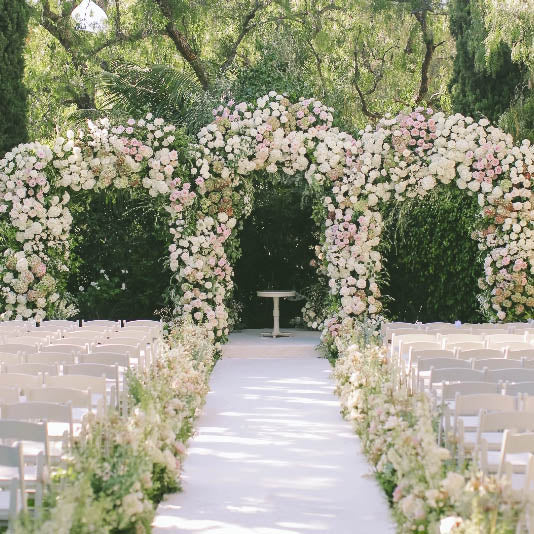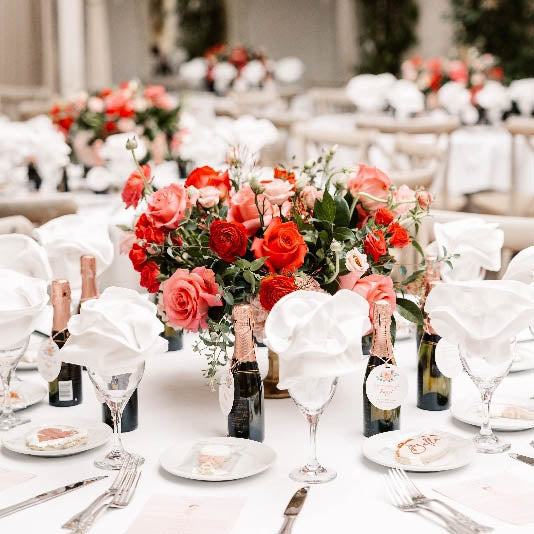
September has two birth flowers: the aster and the morning glory. Different traditions list different blooms, which is why both are celebrated this month. Asters are a strong late-season cut flower that hold their color beautifully for days, while morning glories are quick climbers that open up with cheerful blooms in the morning before closing when the sun gets hot.
I’m Amy Marella, owner of The Hidden Garden in Los Angeles, and I’ve been designing with flowers for more than twenty-five years. From A-list events to intimate celebrations, I’ve worked with just about every bloom you can think of and I know which ones really shine when it counts.
In this post, I’ll walk you through the meaning, bloom timing, care tips, and styling ideas for both September birth flowers. And of course, I’ll share a few of my own favorite tricks for working them into arrangements and floral gifts.
Aster
Photo credit: Flickr.
Symbolic Meaning
The aster has an unspoken connection with people born in September. The flower represents wisdom that comes from real life experience and the patience needed to nurture lasting connections. Building on those themes, it's often a symbol used to convey lasting affection.
When a September baby receives asters for their birthday, it’s deeper than just giving a gift. You’re acknowledging their loyalty and respect. This is why the aster has endured as a September symbol over time. It shows thoughtfulness and communicates that you know this person inside and out.
Color and Variety Info
Asters have a star-like look with narrow petals that spread from a tight center. The petals are fine and slightly pointed, giving the bloom a layered texture you notice right away. Most have a small yellow center that pops against the cooler petal tones. They grow on slim stems with narrow leaves, and when they bloom together they create a full and lively display that works beautifully in late-summer and early-fall arrangements.
They grow in purple, pink, blue, and white colors though not in equal measure. The variety of Aster seen most often is purple, blanketing gardens and meadows toward the end of summer. On the other hand, the rarest color is blue, which usually comes from growers who work with specialty blooms.
History and Cultural Significance
Centuries back, asters were cultivated in ancient Greece, where they were thought to bring protection and ward off bad luck. Their name is taken from the Greek word for star. Over time, they spread across Europe and became a staple in cottage gardens, prized not just for their late-season bloom but also for their resilience.
Chinese artists have been painting asters for centuries, often pairing them with chrysanthemums to capture the look of autumn. I’ve seen scrolls where every petal is painted with such care it feels like the bloom could lift off the page. Historical records show they were grown in imperial gardens, valued as much for their place in seasonal traditions as for the color they brought to the landscape.
One detail many don’t know is that asters are related to sunflowers and daisies, sharing the same botanical family. This connection explains their similar petal arrangement while still giving them their own distinctive identity, aside from being the birth flower of September.
Blooming Information & Care Maintenance
Peak blooming usually comes in late summer, and September is when these flowers really put on their best display. That’s part of the reason they’ve become such a staple for the month. While plenty of plants are fading by then, they’re still producing fresh, colorful blooms.
They do well in a sunny spot with soil that drains easily. In hotter areas, some afternoon shade can help them last a bit longer. I always water at the base to keep the foliage dry and avoid mildew.
For cut stems, I’ve had the most success harvesting in the early morning and putting them straight into clean, lukewarm water. Changing the water every couple of days and trimming the ends slightly keeps them fresh well after they’ve left the garden.
How To Use Asters In Flower Arrangements
Balancing an arrangement often comes down to what you place between the large feature blooms and the finer filler stems. Asters are ideal for that middle space because they bring texture while keeping the design cohesive. Clustering them in a few spots rather than spacing them evenly adds dimension. And choosing a color that plays well against the surrounding flowers can make the whole arrangement stand out.
Gifting feels more personal when the flowers match the season, so I often pair them with dahlias or chrysanthemums. As September’s birth flower, asters are an easy way to make a gift feel more special. For an even more personal touch, I sometimes source a less common color, like a pale blue so the gift feels extra unique.
Morning Glory
Photo credit: Flickr.
Symbolic Meaning
Mornig glory is symbolically tied to love, affection, and the beauty found in brief moments. Its blooms open with the sunrise and fade by evening, which is why it’s often seen as a reminder to appreciate what each day brings. Many cultures connect it to gratitude and the joy of having someone in your life.
When given as a September birth flower, it carries a message that love is real and worth cherishing even when it’s fleeting. This mix of romance and awareness of life’s pace is what has kept morning glory present throughout September, a month synonymous with some of the darkest moments in American history.
Color and Variety Info
Trumpet-shaped blooms with smooth petals that flare gently at the edges make morning glories easy to recognize. A pale center often fades into richer tones, with fine lines running outward through each petal. They grow on slim stems with heart-shaped leaves, climbing over fences, trellises, and anything else they can reach. Flowers open with the sunrise and usually close again as the day warms.
Most of the time you will see them in shades of purple, especially in spots where they’ve been self-seeding for years. They also come in the colors white and magenta, however you will struggle to see magenta in the wild as they’re often specially grown by botanists.
History and Cultural Significance
Morning glory has roots in Mesoamerica, where it was grown both for its color and for practical uses like dye and working rubber. Traders eventually brought the seed to Japan during the Heian era, and that’s where the real breeding boom happened. By the Edo period, growers were producing new colors and petal patterns that were ready to show off as soon as the blooms opened in the morning.
In Tokyo’s Iriya district, summer fairs became the place to see this September birth flower. Streets filled before sunrise with rows of potted morning glory, each grower hoping their variety would catch a buyer’s eye. Some patterns were so unusual that people would come back year after year looking for them. I like how the whole event matched the flower’s nature of an early burst of energy before the day moves on.
Blooming Information & Care Maintenance
Late summer through early fall is when morning glory is in peak. In warmer areas you can get flowers right up until the first frost. Buds start opening with the sunrise and by the time the afternoon heat rolls in, most have already closed. I’ve seen them cover an entire fence in a single season when they have the right conditions.
Getting the seeds started well is the first step. I either nick the outer coat with a nail clipper or give them an overnight soak. That little bit of prep makes them sprout faster and more evenly once they hit warm, well-drained soil.
Training early keeps growth where you want it. Wrap morning glory stems around their support in the same direction each time, then secure lightly with soft ties at two or three points.
They love strong sun and don’t need rich soil. In fact, too much fertilizer gives you a lot of leaves and not many blooms. I water at the base to keep the foliage dry, and in crowded gardens I’ll make sure there’s good airflow to keep mildew away.
How To Use Morning Glory In Flower Arrangements
Morning glory works best in floral designs that prioritize movement. I’ll weave the stems through a hand-tied bouquet so they guide the eye from one side to the other. A small cluster near the collar brings color right up front, and I like letting a single stem trail from the binding point for a soft finish.
For morning events, they blend beautifully with dahlias or garden roses, while zinnias bring a brighter but more casual look.
When it’s for a gift, I often train a morning glory on a small hoop or obelisk in a ceramic pot. It keeps things neat and makes it easy for the recipient to enjoy it indoors or on a patio. Adding a simple tag that marks it as September’s birth flower gives it that personal touch. If the gift has to be cut flowers, I recommend planning delivery early so the blooms are wide open when they see them.
Continued Reading
Loved learning about September’s flowers? Don’t stop here! We’ve also created guides for July’s birth flower and August’s birth flowers - each with their own beautiful stories and meanings. It’s such a fun way to see how flowers reflect the personality of each month.






